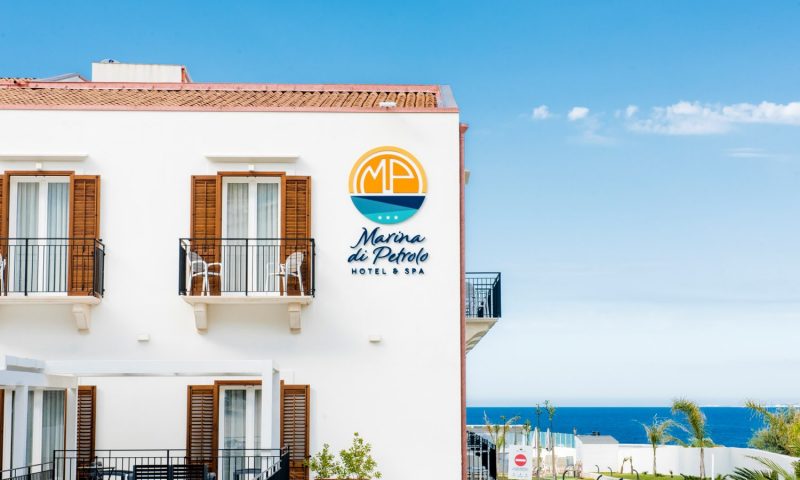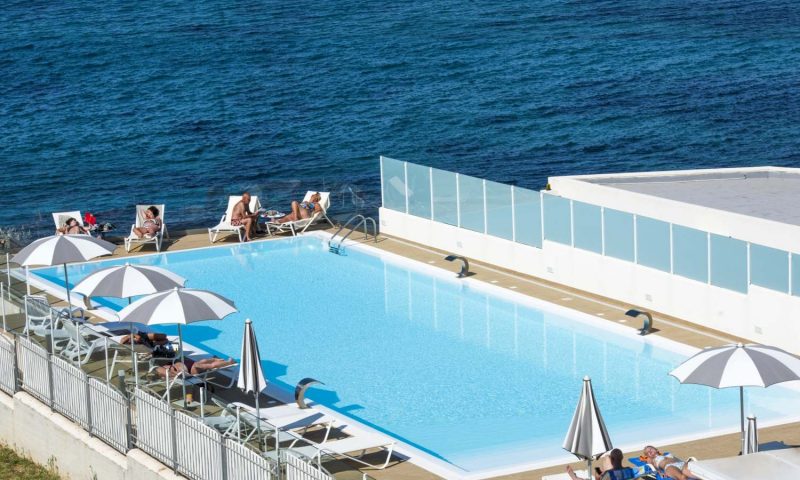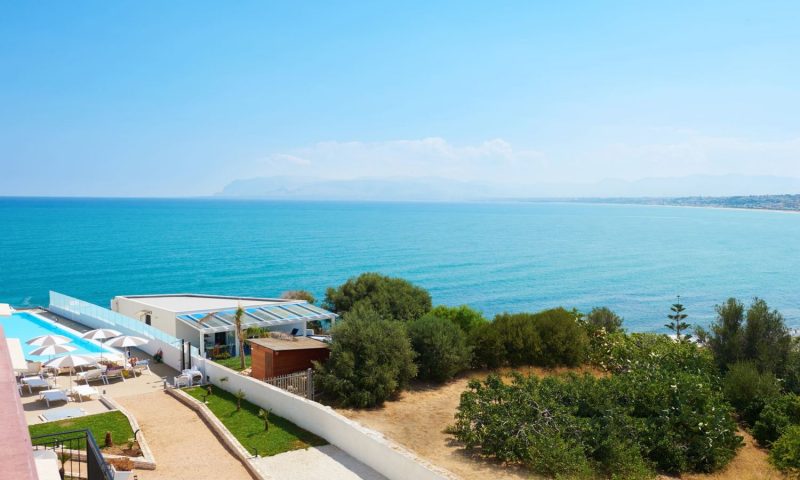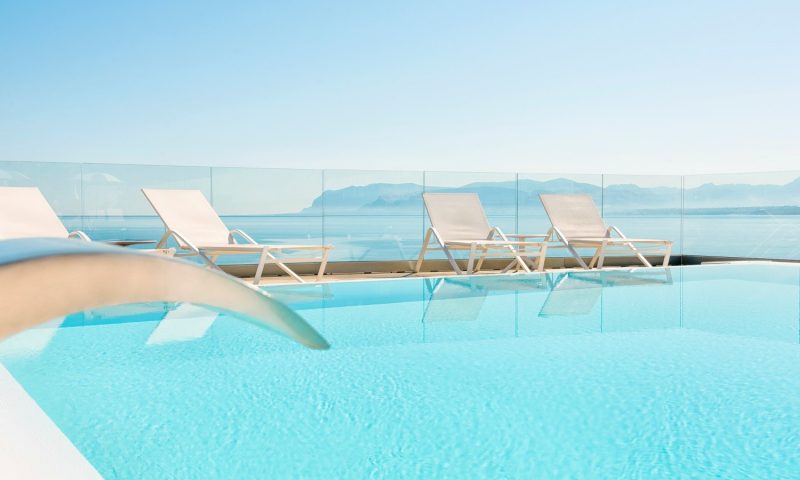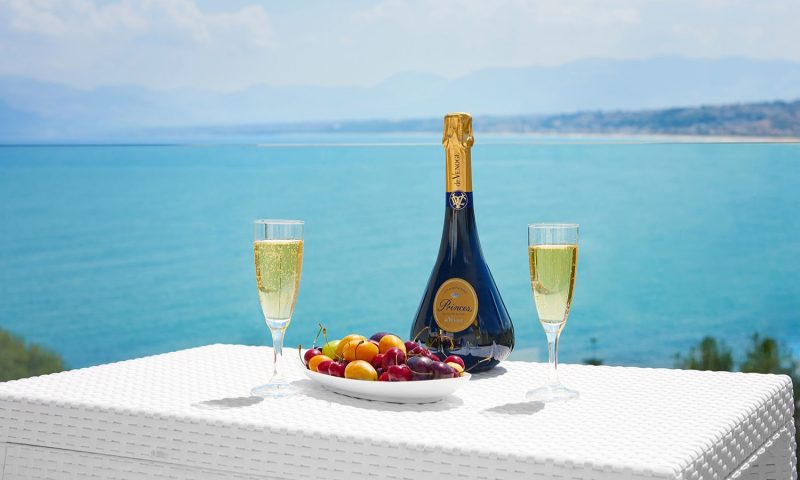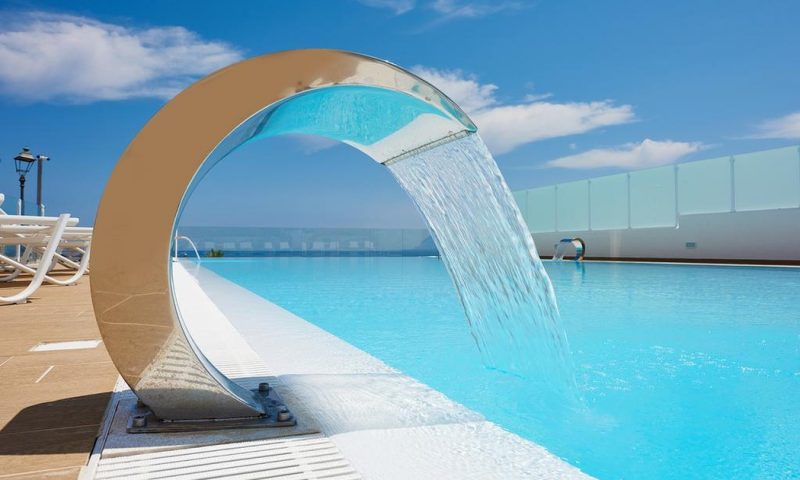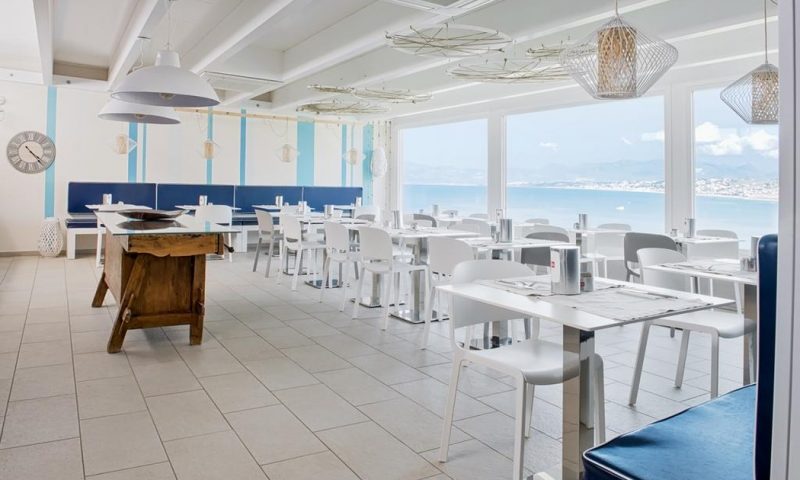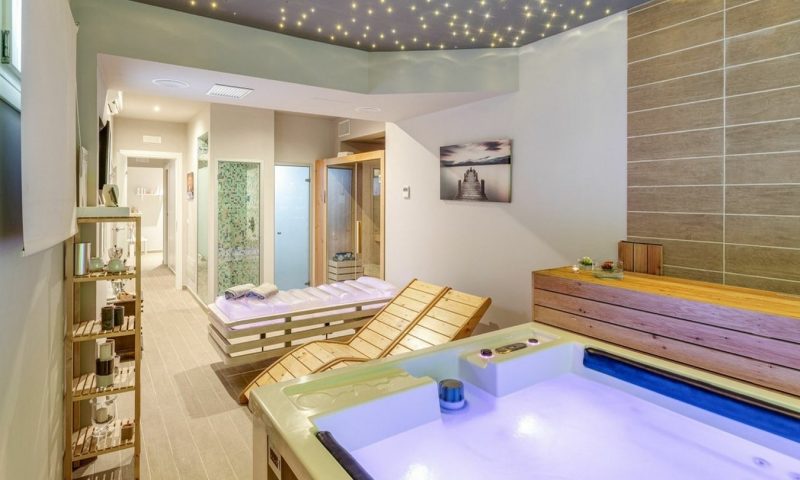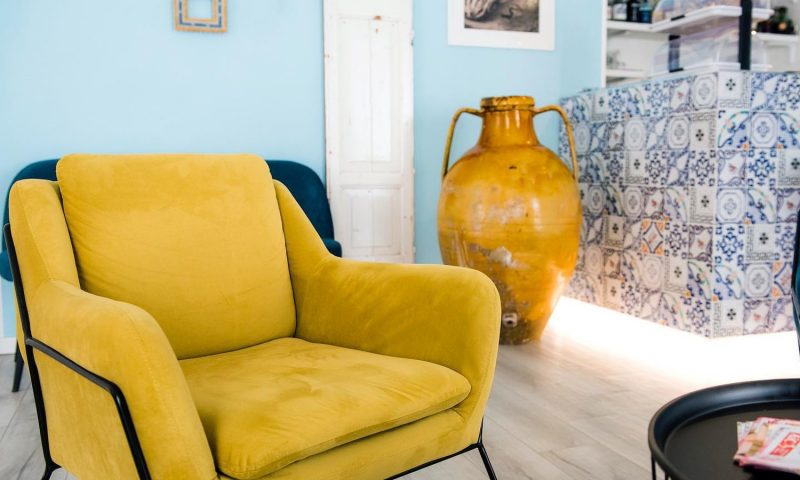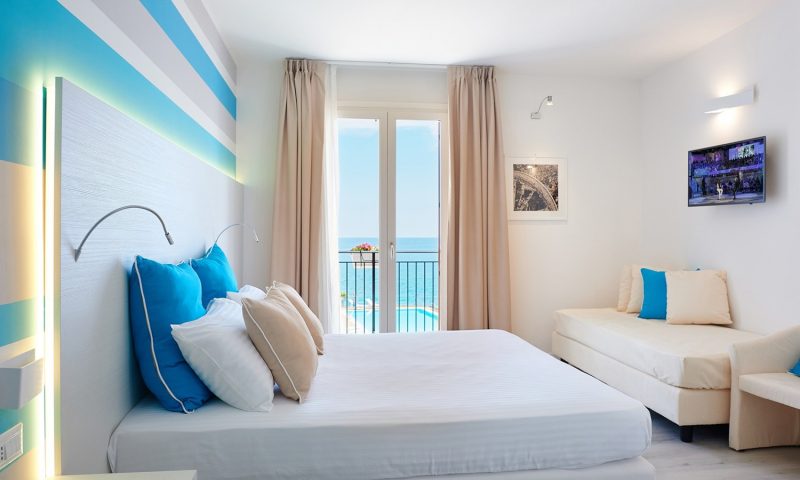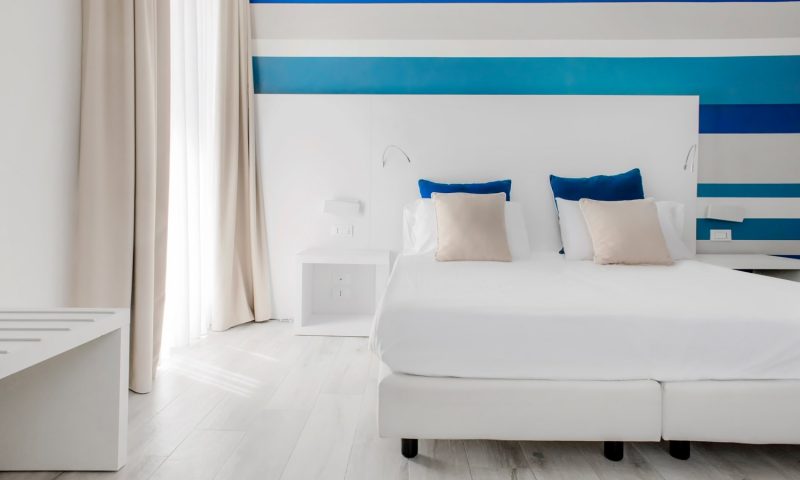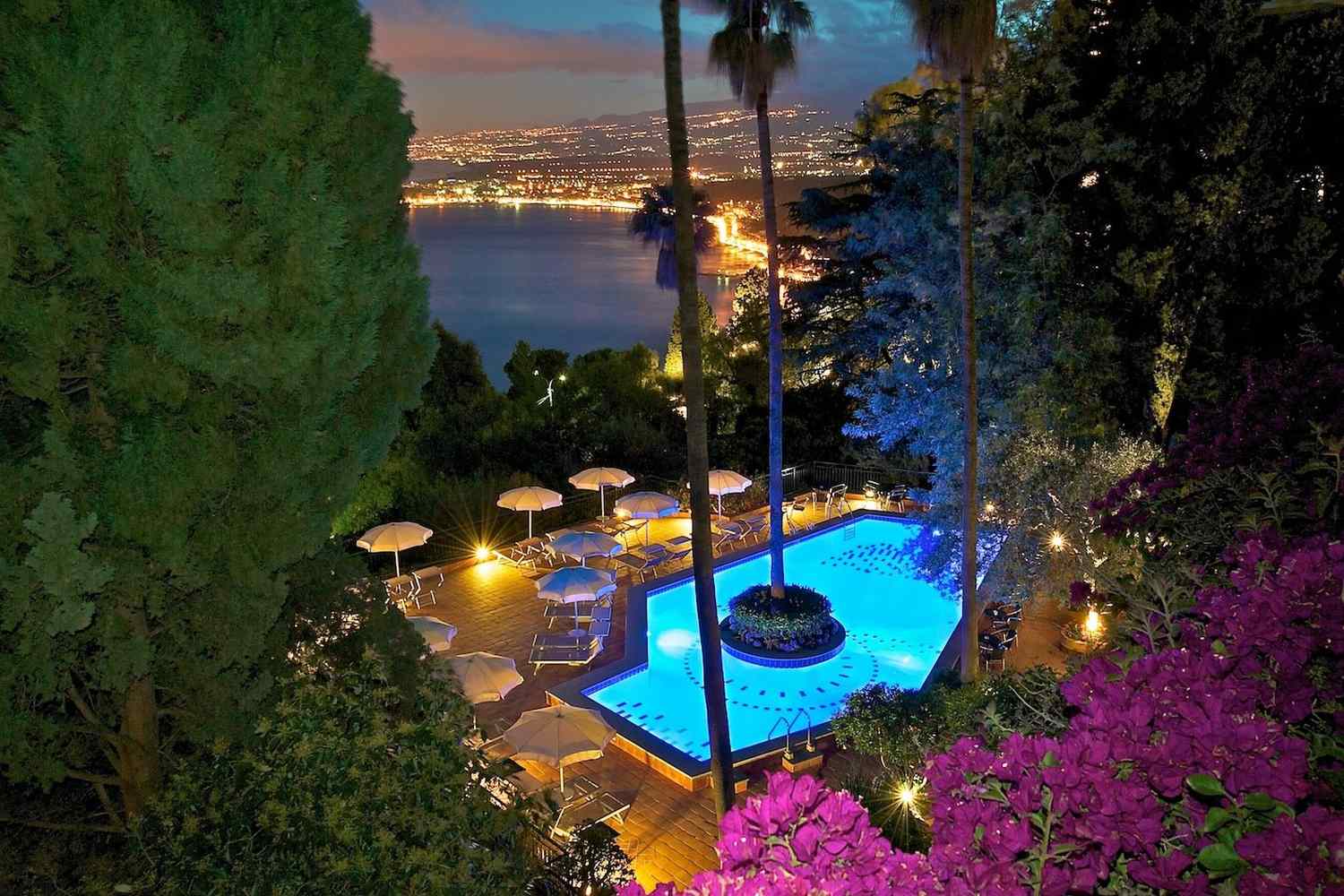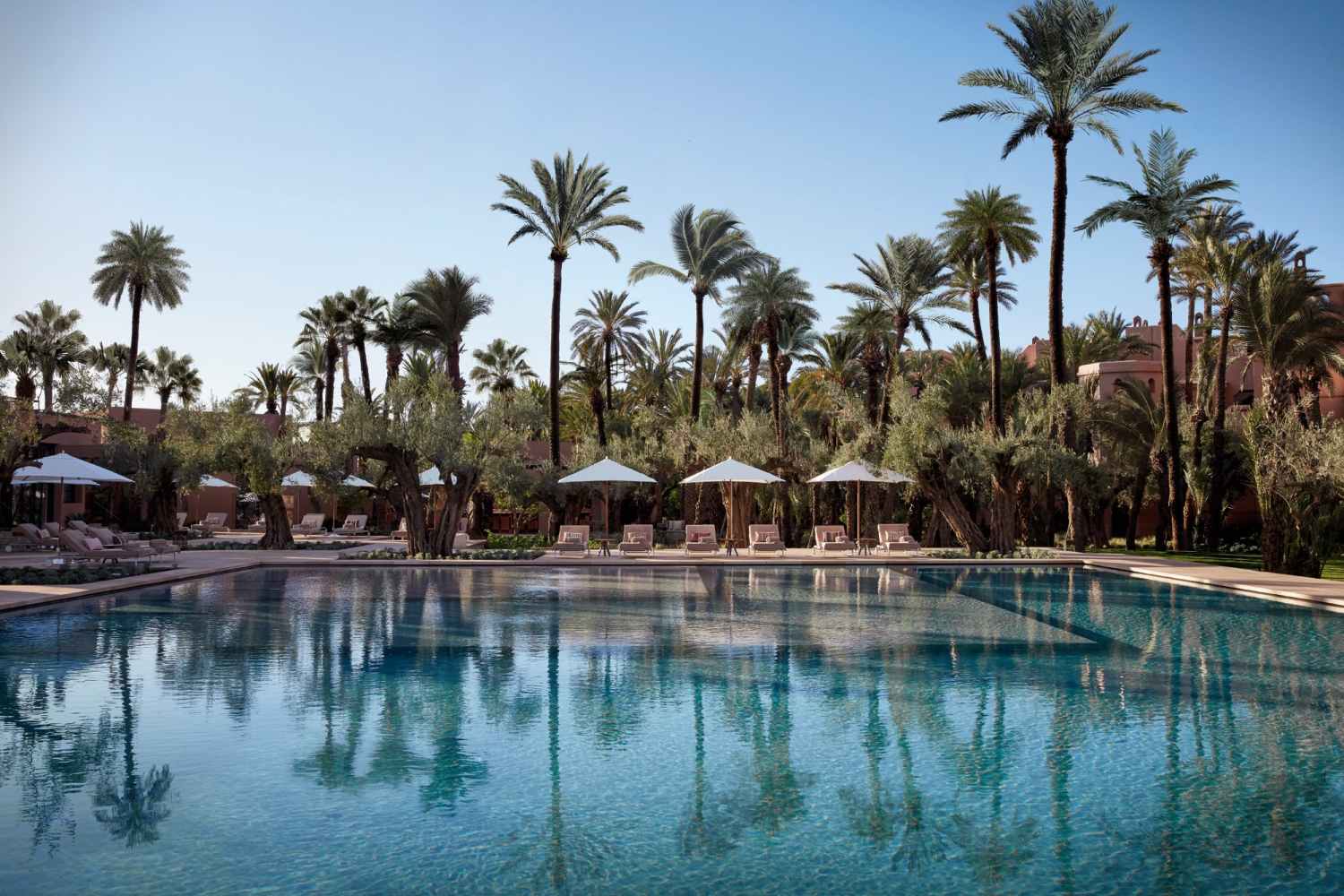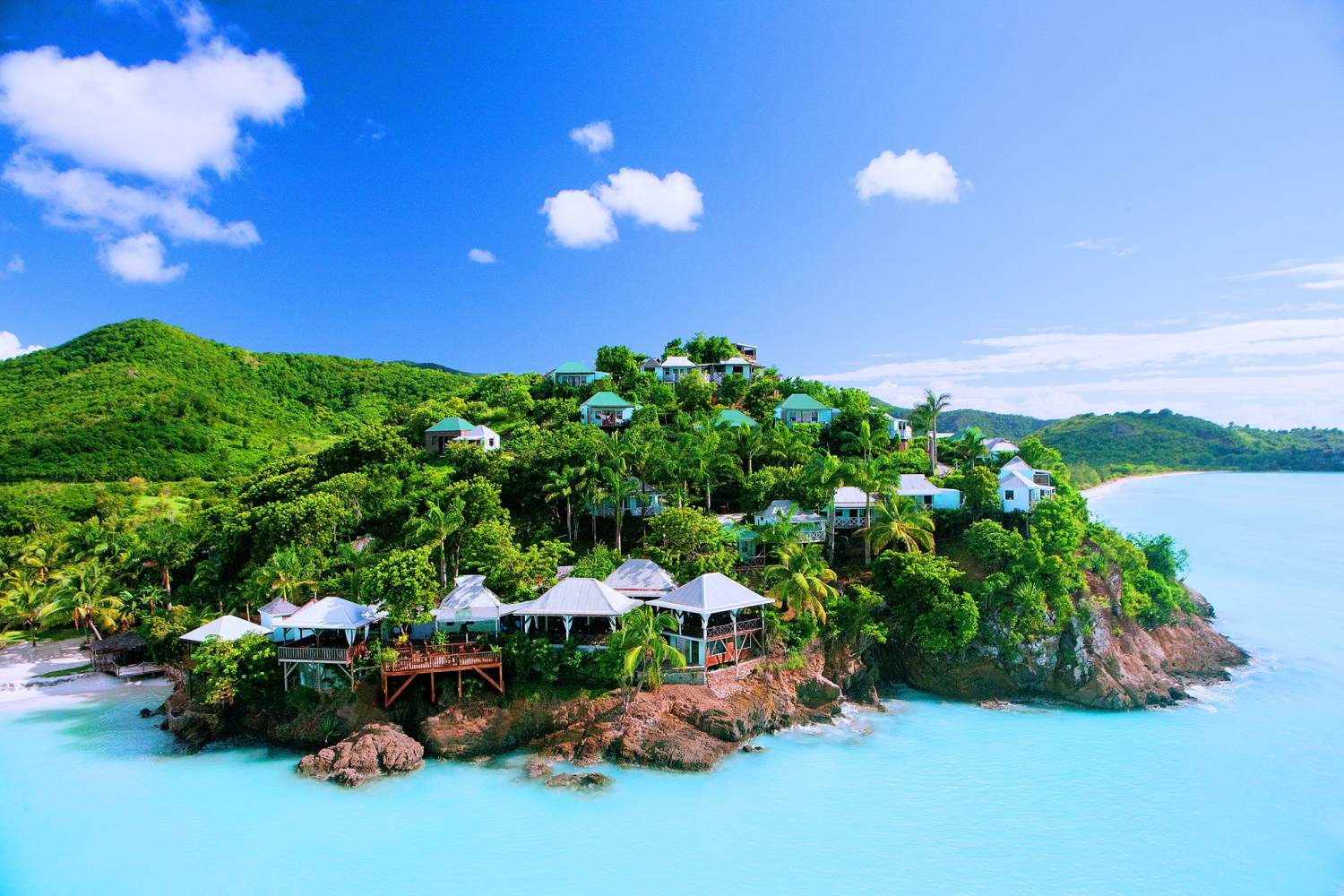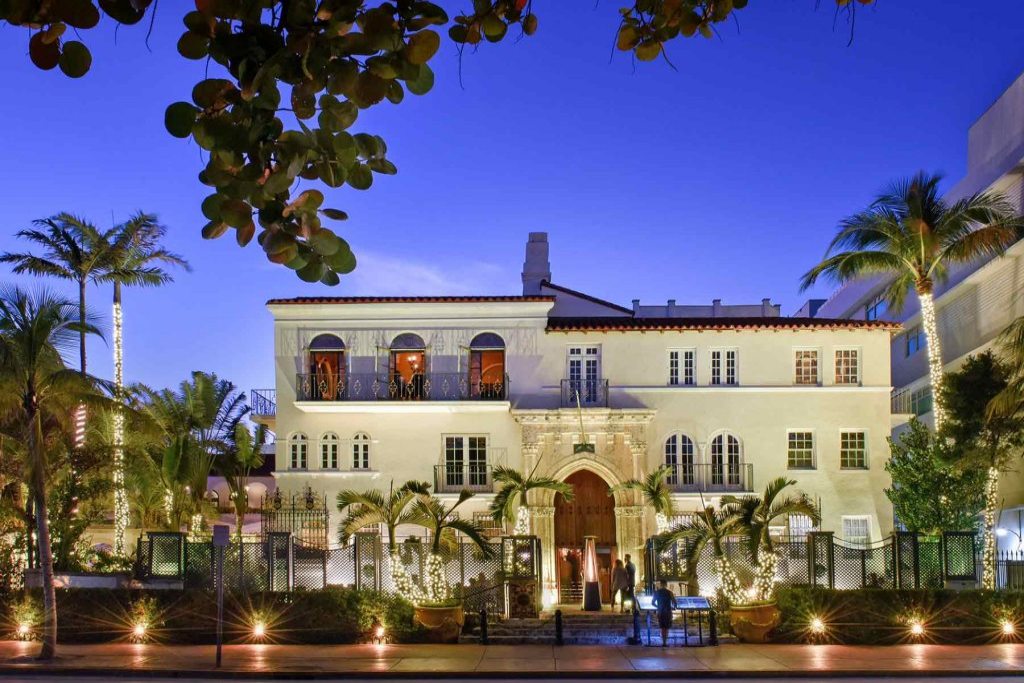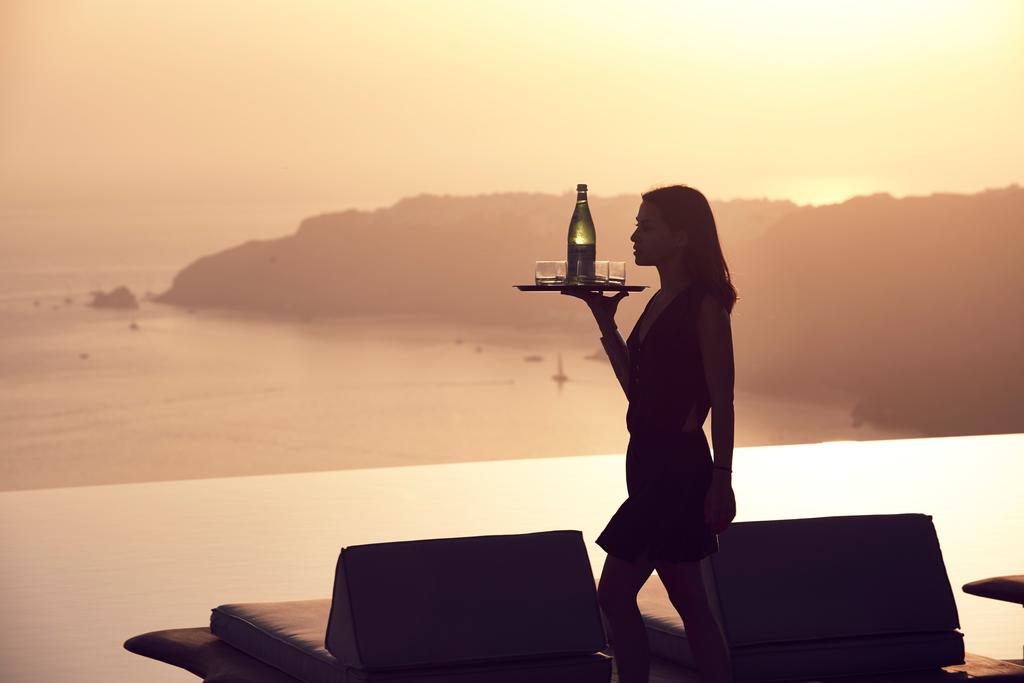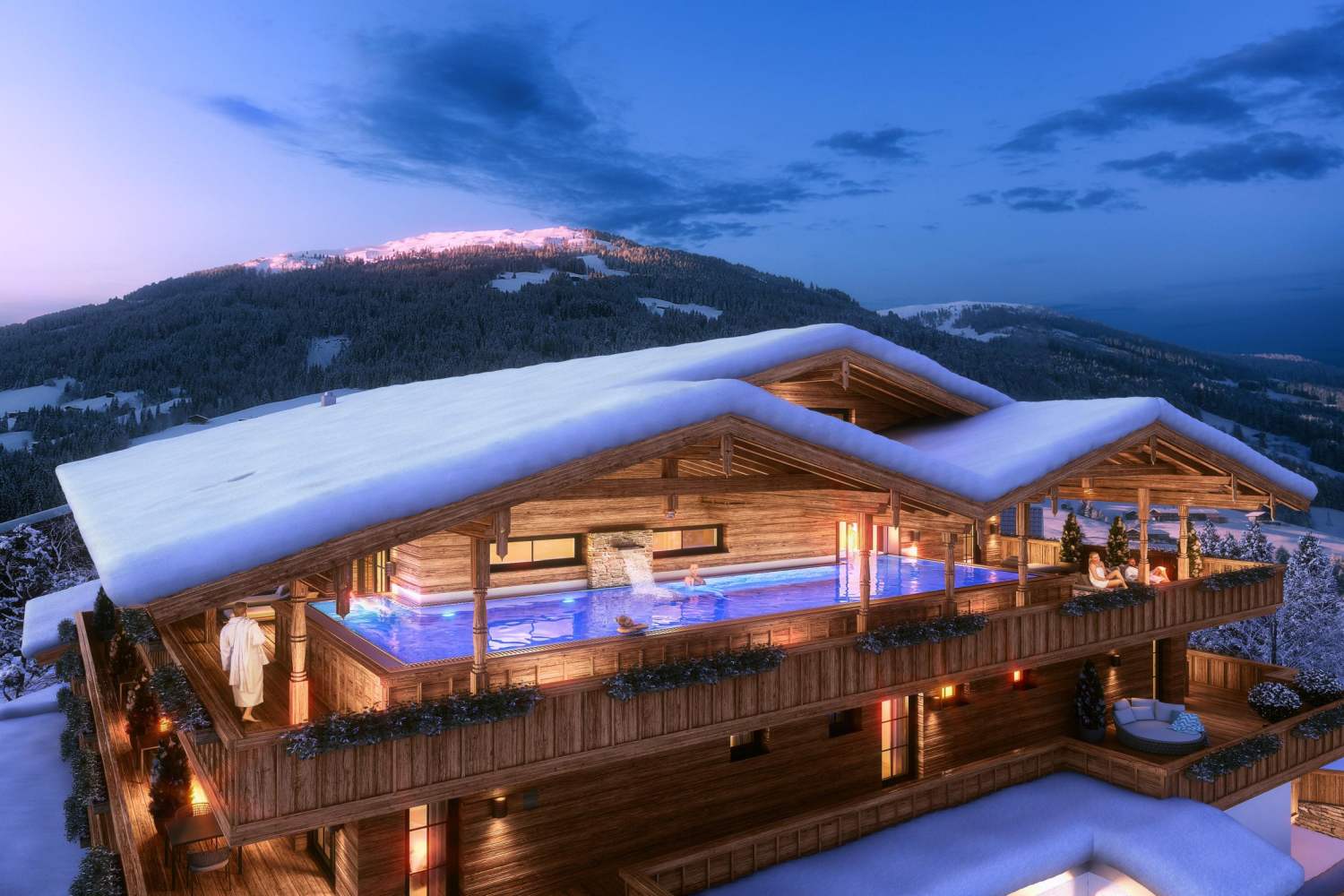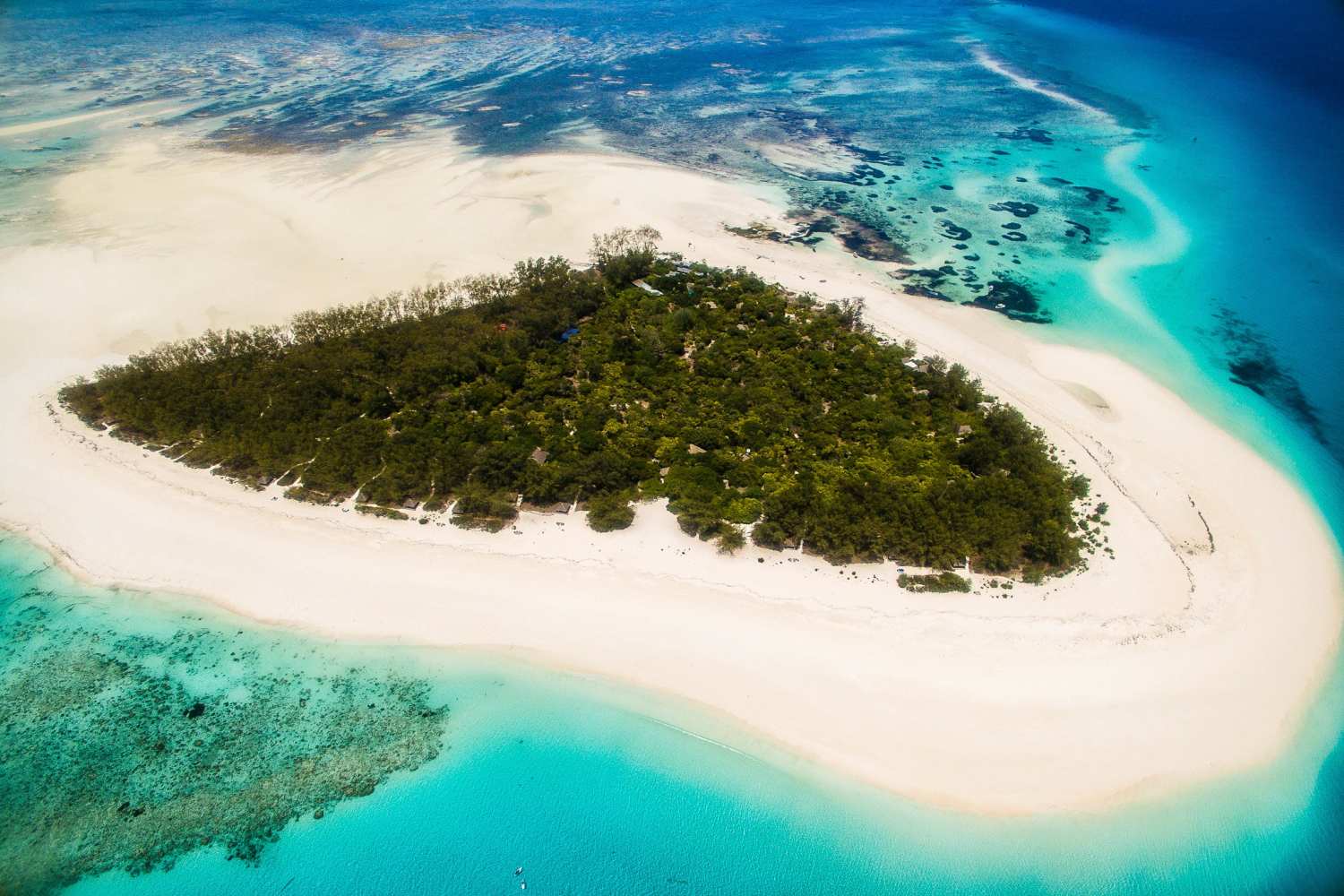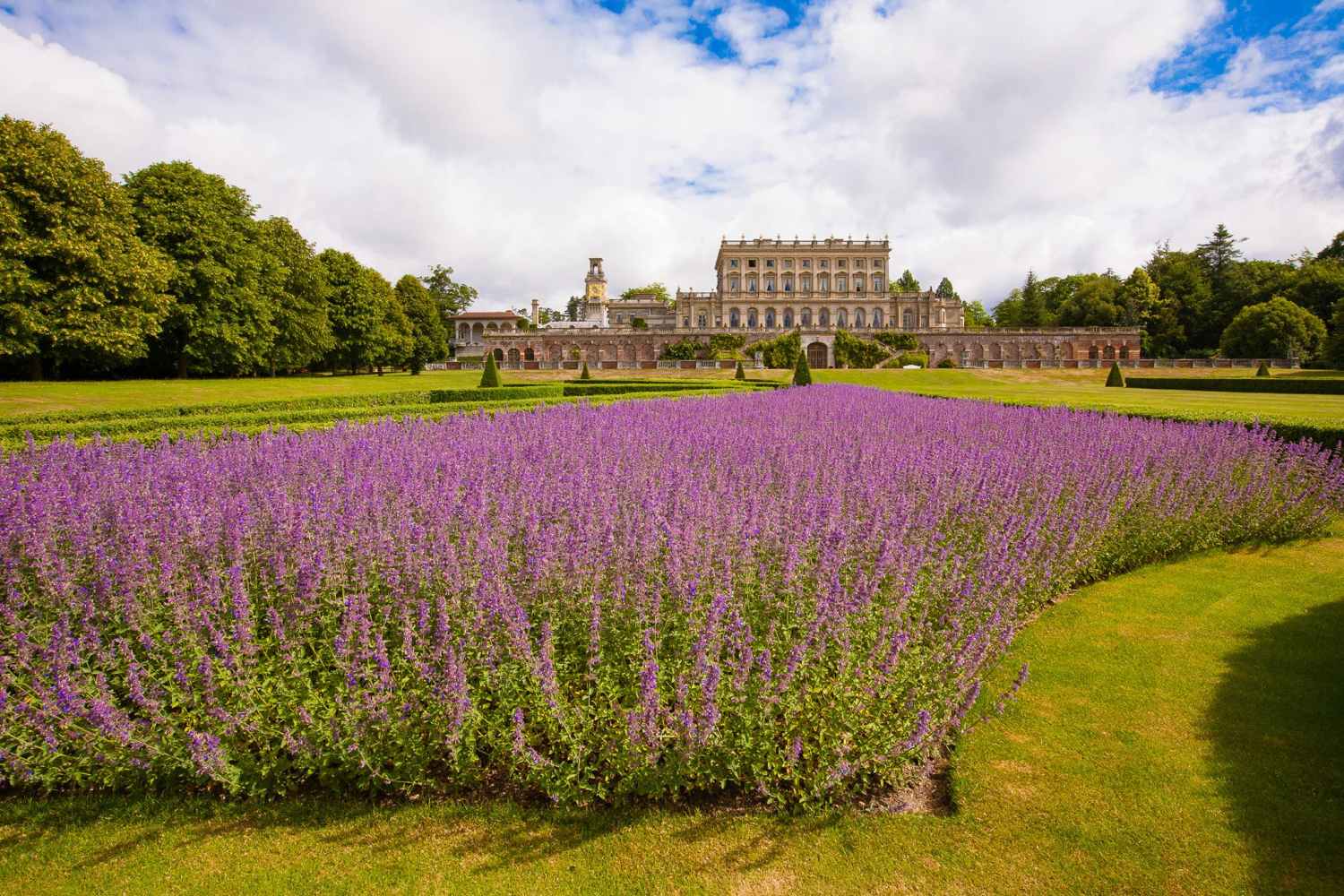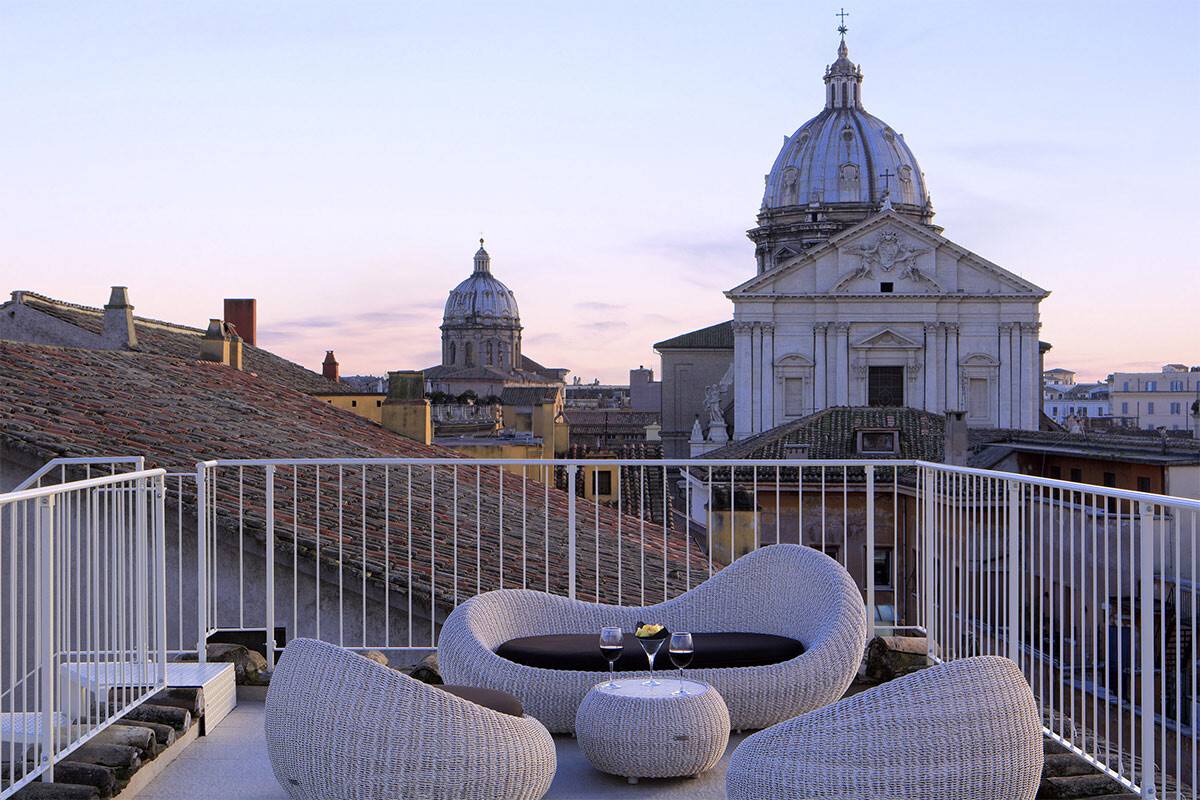The hall of the Marina Di Petrolo Hotel & Spa is the first shared space, the most important. A place that welcomes travelers from all parts of the world and therefore for its nature has an international soul that incorporates, in design and space, techniques of ancient Sicilian walls blending tradition and innovative design.
3-star hotel in the historic center of Castellammare del Golfo, in the province of Trapani. Sea view rooms and apartments, with panoramic outdoor swimming pool, breakfast room on the terrace, wellness center with SPA, massage area, beauty center, Technogym gym, private parking.
An ideal location for visiting Western Sicily, with its beauties such as the Tonnara di Scopello and the Riserva dello Zingaro, but also San Vito Lo Capo, Segesta, Erice, Trapani and Palermo.
ROOMS
Our 19 rooms are divided into different types to meet the needs of each client. Solar colors, simple and clean lines in design, furniture designed and made with care, with furnishing accessories made by the best Italian and international companies.
All rooms are air conditioned, soundproofed and hypoallergenic, and are equipped with private bathroom with chromotherapy shower, minibar, hairdryer, smart LED TV with SKY satellite channels, telephone, safe and high speed Wi-Fi.
Environments and spaces have been designed down to the last detail and designed to make the stay in the hotel a pleasant experience. The rooms, in a modern style with functional furnishings, are the ideal solution for a holiday in Castellammare del Golfo, rich in comfort and services, with an excellent quality-price ratio.
The rooms sea-view, thanks to their location, dominate the entire Gulf of Castellammare. A unique, rare sight that allows you to admire the incredible panorama that goes from San Vito lo Capo to Punta Raisi.
Our rooms, furnished to measure, are air conditioned, soundproofed and hypoallergenic, equipped with private bathroom with chromotherapy shower. Complete with minibar, hairdryer, smart LED TV with SKY satellite channels, telephone, safe and high speed Wi-Fi connection.
INFINITY POOL
Close your eyes, imagine being at the sunset time, while sipping a cool aperitif, admiring how sky and sea blend on the horizon. Let yourself be overwhelmed by the emotions in an oasis of tranquility, enjoying the sun of Castellammare del Golfo lying on a sunbed. Relax with the jets coming down from the small waterfall fountains, the atmosphere around you will do the rest.
SPA SERVICES
Enjoy pleasant moments of healthy relaxation thanks to the services offered in our SaleMarino SPA. The wellness package includes a sauna, emotional shower, whirlpool bath, Turkish bath, heated water bed, in a high concentration of iodine thanks to the wall of Himalayan salt, accompanied by top quality infusions. Let yourself be overwhelmed by the relaxing atmosphere!
WELLNESS PACKAGE
Our SPA access includes exclusive access to the SPA for 90 minutes up to a maximum of 4 people, with an air-conditioned environment equipped with all comforts and consists of:
- Finnish sauna, which possesses extraordinary relaxation and detoxification abilities and has positive influences on the mind and body. Nothing is more effective for relieving nervous tension and calming anxiety, because the sauna stimulates the natural rebalancing of psychophysical conditions. The skin is purified and with sweating acids and toxins are eliminated;
- Hot tub, which will have the ability to release stress and muscle tension from the body. This is thanks to the gaseous bubbles which in contact with the skin cause a natural micro-massage capable of stimulating circulation and giving a pleasant sensation of relaxation;
- Shower with chromotherapy, with the colors and tones of light that radiate towards a specific part of the body, transmitting the vibrations that bring the energies back into balance;
Himalayan salt wall which, by iodizing the environment, brings respiratory, dermatological and stress-relieving benefits; - Heated water bed, which gives an immediate feeling of well-being to both body and mind, thanks to the union of water and light which represent two natural elements of great emotional impact.
- Herbal tea, with different variants of your choice, to conclude the journey.
CASTELLAMMARE DEL GOLFO
Castellammare del Golfo bases its identity on the sea. Born as a marine emporium for the businesses of the nearby Segesta, the watchtowers and the defensive ramparts of the castle are reflected on its sea, and life takes place on the sea and summer evenings come alive.
Nearby there are still archaic landscapes such as the village of Scopello, leaning on a rock overlooking the stacks and the old tuna. In the territory of Castellammare falls the main entrance and part of the Zingaro Nature Reserve where, alongside pristine beaches, there are important endemic manifestations of flora and fauna.
For caving enthusiasts, the caves of Monte Inici are unmissable with very deep “horrors”, underground lakes and glimpses of extreme suggestion.
SEGESTA ARCHAEOLOGICAL PARK
Segesta, located on Mount Barbaro, is presumed to be founded by the Elimi family around 1200 BC The Elimi, a group of people belonging to the migratory waves to the west after the Trojan war, landed some in Magna Grecia, others in Sicily, along already known routes , as claimed by historical and archaeological sources.
According to Thucydides and other historians, these people settle in Erice and Segesta, the main center of the Elymians. Of this city, formerly called Egesta, some authors want to make believe that the origin is divine; according to Servio Egesta, the young daughter of Hippotes, “on the ship she was made pregnant, and when she came ashore, she gave birth to the Former Father of Segesta, to whom she imposed the name of her mother …”.
Cicero gives to Enea the foundation of Segesta saying “Segesta est Oppidum pervetustum in Sicily, Judices, quod ab Aenea fugiente in Troja, atque in hac loca veniente, conditum esse demonstrant”.
His first historical records date back to 580 BC: he fought against Selinunte – destroyed in 409 – but succumbed to power before Carthage and then Rome; he suffers first the wrecking of Verre, and after the invasions of the Vandals.
From the remains of a small church that came to light during an excavation, it is presumed that it was a village in the Byzantine period, and that it was still inhabited during the time of the Saracens.
Today we know of Segesta, as well as the famous temple and theater, another sanctuary discovered at the foot of the southern wall of Monte Barbaro, in the Mango district, inside which there are remains of Doric temples of the sixth and fifth centuries BC.
We do not know to which divinities – Ceres, Diana or Egesta – the two sanctuaries were consecrated; their structures prove the relevant influence of the Hellenic models. The magnificent temple has a typically Greek style, although presumably unfinished.
The theater, which can hold about eight thousand spectators, was brought to light in 1822 by the Duke of Serradifalco, president of the Commission for Antiquities and Fine Arts of Sicily. Its structure highlights three eras: a prehistoric, a Greek-Hellenistic and a later one of completion.
In the summer there are classical and folk performances. The Sanctuary of Mango was surrounded by a “temenos” built in large blocks, according to the classical style. An important excavation has brought to light attic ceramics with graffiti inscriptions in the Elymian language.
All these data confirm the testimony of Thucydides on the links between Segesta and Athens, but we do not know exactly what the degree of Hellenization of the city was.
The Temple of Segesta is evoked more than described in the stories of all travelers; we remember the famous text of Goethe “the position of the temple is extraordinary: at the highest end of a long and wide valley, on an isolated hill and surrounded by precipices, it dominates far and wide a wide expanse of fields, but only a short stretch of sea …
The wind whistled among the columns like in a forest and some grifagni birds rolled over the carcass of the temple, filling the sky with screams “.
ZINGARO NATURAL RESERVE
It was the first nature reserve established in Sicily (Law n.98 of 1981), also following an environmental demonstration that in 1980 formed a human chain from Scopello to San Vito Lo Capo; incorporates a stretch of about 7 km of beautiful and unspoiled coastline overlooking the Gulf of Castellammare and a chain of mountains that, to the small coves and the striking cliffs on the sea, is a magnificent setting.
The most interesting reliefs are the Monte Scardina, the Monte Passo del Lupo, the Monte Speziale which with its 913 meters is the highest peak of the reserve. The outcropping rocks are limestone, dolomite and marl.
The Reserve, of 1600 hectares, can be walked on foot through the paths; the most representative routes of the various aspects of the Zingaro are three: the first runs entirely along the coast between the South-East entrance (on the Scopello side) and the North entrance (on the San Vito side); the second interests for half the previous one and then proceed to one of the zones of the upper Zingaro and return to the sea; the third, finally, the most challenging, is practically a complete tour of the Reserve, affecting both the coast and the entire upper part of the Reserve.
The Gypsy lived on foot enchants for its harsh beauty, for the intense colors in every season: the fragrant turquoise sea, the white coves, the omnipresent green dwarf palms, the luxuriant lentisks and terebinthos, the tenacious olivastri and carob trees, the bright colors spring and autumn flowers in the pastures, the golden summer coat of the slopes of the mountains, the harmonious shapes of the rural houses.
In fact, the Gypsy is also and above all a reserve of the landscape, an ancient association of man with the earth. The coast is like a string of pearls seven kilometers long.
A series of sheer cliffs, rugged headlands, magnificent coves, deep indentations, underwater caverns and tunnels, low cliffs, narrow valleys, fantastic pebble beaches and sands that are reflected in a pristine sea with changing tones: here blue, turquoise, light blue.
Interesting is also the existence of a “sidewalk” (trinoir in French) calcareous constituted by shells of vermetidae, (gastropod molluscs with shell-shaped tube), bivalve molluscs, calcareous algae and other intertwined and welded organisms.
There are only a few examples in the Mediterranean, and it is an important example – like coral reefs – of rocks “bioconstructed” by living organisms.
The Reserve, placed in continuity of the series of calcareous reliefs of Mesozoic origin of Palermo, not far from the interesting Monte Cofano that stands isolated to the West, has a distinct diversity of environments that partly house phytocenosis of great naturalistic interest and sometimes even landscaping.
The general climate is also important for the vegetation, with an average annual temperature of 19 ° C and a rainfall of 645 mm. Even when it does not rain, in the mountains, there are benches of fog coming from the sea, which support local humid microclimates.
The Zingaro is a biological environment very rich in species: in a few years of research have been cataloged about 700 species of which at least twenty are endemic or rare, elsewhere often extinct or in serious danger of extinction.
Among the most widespread and important for the agricultural economy of the past, it is certainly worth mentioning the manna ash, a tree used not only to extract the manna, but also to obtain a wood particularly suitable for the construction of agricultural tools.
SCOPELLO
On the rocks above the tonnara are visible two towers, one of the thirteenth century of which only the ruins are part of the complex of the tonnara, and the second, of the fifteenth century, which was designed by the Florentine engineer Camillo Camilliani and which does not fall within the territory pertaining to the tonnara.
The era of construction of the first nucleus and of the tower located on the rock should not be earlier than the thirteenth century, this dating is evident from the examination of some construction techniques typical of that era: for example that adopted in the vault with small segments that covers one of the environments of the marfaraggiu or in the walls of the same tower.
The oldest nucleus is easily identified in the body of the building that is leaning against the rock on which the said watchtower rises: these first structures were built by the royal domain and the tower was used to defend the tonnara and the territory of Scopello.
TERME SEGESTANE
Free baths of Segesta, also called Polle del Crimiso are volcanic spas that are located near the plant between Calatafimi Segesta and Castellammare del Golfo.They are surrounded by reeds and tamarisks, enclosed by rocky walls of white travertine streaked with pink.
A picturesque landscape and above all free, because you can immerse yourself in the small coves without spending a single euro. The water of the free baths of Segesta flows from the source to a temperature of about 47 degrees.
There are three springs: Bagno delle Femmine, Grotta Regina and Nuova Sorgente to make thermal baths, mud and anti-therapy, useful in giving benefits in case of rheumatic, respiratory and skin diseases.
According to the Greek legend, the water is so hot for the will of the deity Krimisòs who had raised the temperature to heat the nymph Egesta, who had escaped from the city of Troy destroyed by the war.
This mythological tale links the foundation of Segesta to the arrival of the Trojans who would have chosen this city for the medical and beneficial properties of the warm waters, which today form the free baths of Segesta.
After a relaxing dip in the thermal baths, you can visit the Temple Doric of Segesta which is located not far away and the entire archaeological site where you can admire the beauty of the past, including a rich and varied vegetation.
In the hinterland, in Contrada Gorga, on the eastern bank of the Caldo River, on the border with the territory of Alcamo, there are other spa services: the alkaline-sulphurous mineral waters, with natural therapeutic qualities, flow from the Gorga spring, located about 50 meters above sea level of the sea, and are collected in a natural basin, between clayey agglomerates, maintaining a constant temperature of 51 ° C.
A conduit of about 300 m. it conveys the waters and muds – consisting of the natural precipitate, without the addition of clay – up to a spa, set in an old renovated mill, also equipped with an outdoor pool and saunas.
PALERMO
«In the public garden near the port, all alone spent a few magnificent hours. It is the most beautiful place in the world. “Johann Wolfgang von Goethe, poet. First Greek and Roman city, then Arab capital, later conquered by Normans and Swabians, this is Palermo, a place where Arabian and Norman preciousness coexist, baroque and liberty taste of monuments, palaces and theaters, but also of gardens and of the markets.
The influence of Palermo’s multiethnic past is visible in the Cathedral, a majestic building begun in the 12th century. and repeatedly remodeled, enriched by an eighteenth-century dome and a medieval bell tower.
Born on a pre-existing basilica, transformed into a mosque by the Arabs and then returned by the Normans to the Christian religion, the cathedral is embellished with gothic decorations and houses the relics of Santa Rosalia, patron saint of the city.
There are also the tombs of the emperors, including Roger II and Frederick II. Nearby is the Palazzo dei Normanni, originally an Arab building, which has always been the seat of power: it contains the Palatine Chapel, rich in Byzantine influence mosaics which, together with those of the church of Santa Maria dell’Ammiraglio (or Martorana), represent real masterpieces of art.
The elegant Martorana, with its tall arched bell tower, dates back to the Norman era, while the monumental Pretoria fountain that occupies the nearby homonymous square is of Baroque style.
The road that goes from the cathedral to the Martorana passes through piazza Vigliena, called the “Quattro canti”, a crossroads decorated with statues and fountains of the seventeenth century.
Piazza della Pretoria overlooks the seventeenth-century Palazzo del Municipio, with a splendid 16th century fountain made up of 644 marble groups. It is in this area that the streets bear names in Italian, Arabic and Hebrew.
From here, moreover, you go down towards the sea, passing through the Vuccirìa, the oldest and most animated market in the city, in Piazza San Domenico, where stands the homonymous church, one of the most interesting Baroque buildings in the city.
Another building of the Norman era is the deconsecrated church of San Giovanni degli Eremiti, with its oriental red domes, built on the foundations of an ancient mosque. In the ancient heart of the city is the imposing fourteenth-century building called Steri (from hosterium, fortified palace), formerly a prison and a court, today the seat of the university rectorate.
Nearby there are the church of Santa Maria degli Angeli, and Palazzo Abatellis, home to the Regional Gallery which houses works of art and paintings ranging from the Middle Ages to the 1700s. The most modern part of Palermo is on the other side of the city.
Overcoming the neoclassical Teatro Massimo, temple of the lyric, in Piazza Politeama you can see the other city theater, Teatro Politeama Garibaldi, built in the mid-nineteenth century in Pompeian style. Attracting town is the characteristic Teatro dei Pupi, the puppet theater, whose protagonists have always been Charlemagne and his paladins.
Along via Libertà, shaded by trees, you enter the area where the nineteenth-century and liberty architecture triumphs, whose splendid symbols are the squared and animated streets.
The Botanical Garden, founded in 1789, is famous for specimens from all over the world. The Zisa (on the homonymous square) and Cuba (in Corso Calatafimi), oriental buildings, dating back to the reign of William II, are further away from the center.
